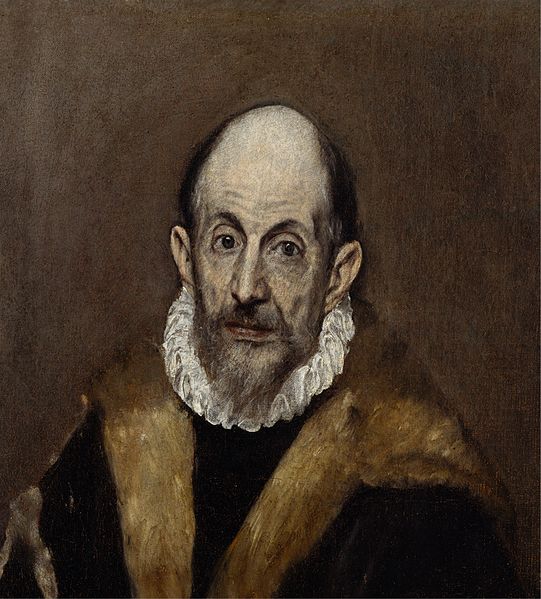
Born: 1 October 1541, Crete
Died: 7 April 1614 (aged 72)
Period: Mannerism, Spanish Renaissance
The Life of El Greco
El Greco, born Doménikos Theotokópoulos in 1541 in Crete, which was then part of the Republic of Venice, is one of the most distinctive artists of the 16th century, renowned for his unique style that combined elements of the Byzantine, Renaissance, and Mannerist traditions. His moniker, “El Greco” (“The Greek”), reflects his Greek origin, though he spent the majority of his career in Spain, where he achieved his greatest successes.
El Greco began his artistic career in Crete, where he was trained in the tradition of Byzantine icon painting. Seeking wider opportunities, he moved to Venice around 1567, where he was influenced by the works of Titian and Tintoretto, absorbing the Venetian use of color and the dynamic compositions that would come to characterize his own style. He later moved to Rome, where he attempted to secure patronage and furthered his study of Renaissance and Mannerist art. Despite his talents, El Greco’s unconventional techniques and personality led to conflicts with some patrons and artists in Italy.
In 1577, El Greco relocated to Toledo, Spain, which became his home until his death in 1614. It was in Toledo that he produced the majority of his most famous works, combining spiritual intensity with bold, expressive use of color and form. His paintings are notable for their elongated figures, dramatic lighting, and deep spiritual emotion, qualities that were not fully appreciated by his contemporaries but which would eventually secure his place as a master of the Spanish Renaissance.
El Greco’s art was deeply personal, often infused with mystical and religious themes reflecting the Counter-Reformation’s intense spirituality. Some of his most notable works include “The Disrobing of Christ” (El Espolio), “The Burial of the Count of Orgaz,” and “View of Toledo.” These works exemplify his ability to convey complex theological concepts through his dramatic and expressive style.
Despite his significant contribution to the art world, El Greco’s work fell into obscurity after his death, only to be rediscovered and celebrated by artists and critics in the late 19th and early 20th centuries. Today, he is recognized not only as a figure of the Spanish Renaissance but also as a precursor to both Expressionism and Cubism, influencing a wide range of modern artists. El Greco’s legacy is that of an artist who was ahead of his time, whose works transcend the era in which he lived to offer a profound and visionary interpretation of humanity and the divine.
El Greco’s Notable Works
El Greco, the illustrious Greek-Spanish painter, sculptor, and architect of the Spanish Renaissance, is celebrated for his unique artistic style characterized by vibrant colors, elongated figures, and spiritual intensity. Here are ten of El Greco’s most famous and influential works:
- The Burial of the Count of Orgaz (1586-1588) – This masterpiece, housed in the Church of Santo Tomé in Toledo, Spain, depicts a miraculous event from the life of Don Gonzalo Ruíz, Count of Orgaz, and is renowned for its heavenly and earthly zones, vivid characters, and spiritual depth.
- View of Toledo (c. 1596-1600) – One of the few landscapes attributed to El Greco, this painting is notable for its dramatic sky and the vivid portrayal of Toledo’s cityscape, emphasizing the deep connection between the city and the artist’s work.
- The Disrobing of Christ (El Espolio) (1577-1579) – Commissioned for the Cathedral of Toledo, this painting depicts Christ being stripped of his garments before his crucifixion, showcasing El Greco’s ability to convey emotional intensity and divine light.
- The Adoration of the Shepherds (c. 1612-1614) – Created towards the end of his life for his own burial chapel, this work is a moving representation of the Nativity scene, characterized by its dynamic composition and luminous colors.
- The Assumption of the Virgin (1577) – This early work, painted for the altar of the Church of Santo Domingo el Antiguo in Toledo, demonstrates El Greco’s mastery of post-Byzantine and Renaissance styles, depicting the Virgin Mary being assumed into heaven.
- Saint Martin and the Beggar (c. 1597-1599) – Exhibiting El Greco’s characteristic use of elongated figures and dramatic contrasts of light and shadow, this painting illustrates the story of Saint Martin sharing his cloak with a beggar.
- The Opening of the Fifth Seal (The Vision of Saint John) (c. 1608-1614) – Known for its influence on modern artists, particularly Picasso, this late work is interpreted as representing the vision of the opening of the Fifth Seal from the Book of Revelation, notable for its intense emotion and dynamic composition.
- Laocoön (c. 1604-1614) – Unlike many of his contemporaries, El Greco’s interpretation of the classical tale of Laocoön, who was punished by the gods for warning the Trojans against the Greek gift of a wooden horse, is set against the backdrop of Toledo, merging classical themes with contemporary settings.
- The Knight with His Hand on His Breast (c. 1580) – This iconic portrait, possibly of a Spanish nobleman, is celebrated for its psychological depth and the dignified poise of the subject, exemplifying El Greco’s skill in portraiture.
- Christ Healing the Blind (c. 1570-1576) – One of his earlier works, this painting demonstrates El Greco’s interest in biblical themes and his ability to render scenes with emotional depth and divine presence.
El Greco’s works are revered for their profound spiritual expression and innovative artistic techniques, which have left a lasting impact on the art world, bridging the Renaissance and the beginnings of modern painting.